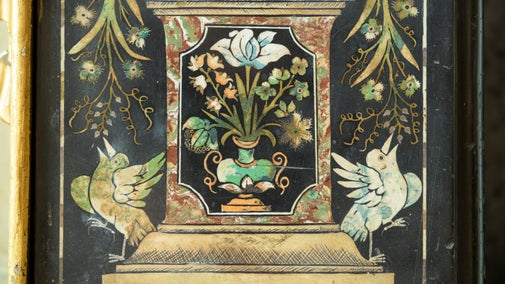
Discover more at Fyne Court
Find out when Fyne Court is open, how to get here, the things to see and do and more.

Fyne Court was once the grounds of a beautiful Georgian mansion with a grand Arcadian landscape. Today, the traditional garden has largely been lost, as has the house, which was destroyed by fire in the 19th century. However, the stories of its most famous resident, Andrew Crosse, and its links to a literary classic can still reveal the secrets of this once manicured garden.
Fyne Court was transformed in the 1750s when Arcadian landscapes were popular. A boathouse, follies, ponds, cascades and a serpentine lake were built, and the house was remodelled.
However, later descendants couldn't afford to maintain the gardens. As you walk through the woodlands you'll discover the remains of their former grandeur.
The house was also lost, destroyed by a fire in 1894. The blaze was believed to have started when a housemaid left a candle she'd been using to heat curling tongs unattended.
Servants and neighbours fought the fire before the eventual arrival of the fire brigade, who'd struggled up from Taunton. No one was hurt, but most of the building was damaged beyond repair.
Only the music room and library survive today, a remnant of this elegant Georgian mansion.
Local businessman John Adams passed Fyne Court to the National Trust in 1972.

Andrew Crosse is Fyne Court’s most celebrated occupant. Living here in the late 18th and early 19th centuries, he was a visionary scientist and poet with a deep love of his native Quantock Hills.
Andrew Crosse was a highly intelligent man whose fascination with electricity ignited when he attended a lecture on the force. He began experimenting by giving electric shocks to unsuspecting friends.
When Crosse graduated from Oxford University, he returned to Fyne Court to run the estate. Here, his near obsession with electricity intensified.
Crosse became intrigued by its presence in the atmosphere and decided to explore this interest further.
He strung up a third of a mile of copper wire in the grounds and connected it to equipment in the music room.
Voltage would build up when there was fog, heavy rain or thunder and lightning. Conducting equipment would begin sparking and flashing, and loud bangs would shake the music room.
Local people began to question what Andrew Crosse was doing and thought he was trying to attract storms. He became known as the ‘Wizard of Broomfield’ and the 'Thunder and Lightning Man'.

In an experiment to generate crystals Crosse found that mites began appearing from a piece of volcanic stone he had put in acid and passed an electric current through.
After repeating the experiment, he found the same results. He informed a local newspaper editor, who published his findings without asking for permission.
As a result, many people accused Crosse of trying to play God and create life.
Crosse gave a lecture on his findings in London, and it has been claimed that Mary and Percy Bysshe Shelley attended.
This has led to the belief that Crosse's lecture inspired Mary Shelley to write Frankenstein. However their presence at the lecture has never been proven.
Andrew Crosse was a man of many talents. He wasn't just interested in the sciences, but also in the arts.
He took inspiration for his poetry from the Quantock Hills where he lived. He reportedly once said that ‘I have a stake through my heart that nails me to Quantock'.
Among the many visitors to Fyne Court, it's reputed that William Wordsworth and Samuel Taylor Coleridge came to see Andrew Crosse.
Coleridge Cottage is only a few miles away from Fyne Court in the Quantocks, and is also under the Trust's care. Andrew’s poems were inspired by nature and the things he saw around him.
Despite the controversy in Andrew Crosse's life, he had two very happy marriages. His first wife was Mary Anne Hamilton, with whom he had seven children.
Andrew married Cornelia Berkeley when he was 66 and had three more children before his death following a stroke.
It's largely due to Cornelia that so much is known about Andrew Crosse. She recorded his life in detail in her books Memorials, Scientific and Literary, of Andrew Crosse the Electrician (1857) and Red Letter Days of My Life.
On his death bed, Andrew changed his will, leaving Fyne Court to his beloved wife, Cornelia. His eldest son, John, was left the organ from the music room.
After Andrew’s death, Cornelia gave the estate to John and his family.

Find out when Fyne Court is open, how to get here, the things to see and do and more.

Fyne Court is a haven for wildlife with clues to its past life as an Arcadian garden. You can also explore the Quantock Hills, with enjoyable walks and captivating views.

Why not pop by the Courtyard Café and treat yourself to a drink or a tasty treat? Or delve into your next adventure by picking up something from the second-hand bookshop?

Learn about people from the past, discover remarkable works of art and brush up on your knowledge of architecture and gardens.